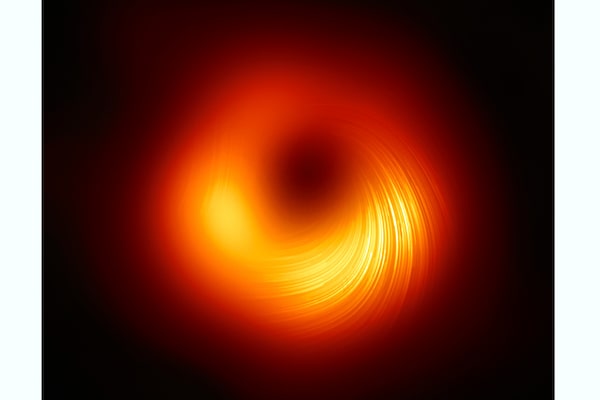
The supermassive black hole at the centre of the galaxy M87 reveals a delicate spiral pattern in this image, based on a re-analysis of observations made in 2018. The pattern is caused by the influence of powerful magnetic fields on the radio waves that are emitted by the hot gas circling around the black hole. EHT Collaboration
Astronomers have added a new twist to their first-ever picture of a black hole.
A reissue of the historic image, first released in 2018, reveals that the giant black hole at the heart of the distant galaxy M87 is the source of a powerful magnetic field – in addition to the fearsome gravitational pull that draws in matter and prevents light from escaping the object’s unseeable depths.
In the updated view, the magnetic field has the effect of giving the ring of high-temperature gas around the black hole a Van Gogh-esque swirl. The black hole, which appears only in silhouette, is at the centre of the image. It is estimated to contain a mass equivalent to 6½-billion suns.
While astronomers have long suspected the black hole is generating a strong magnetic field, the new image offers the most direct evidence yet of the field’s presence and a glimpse at the complex interplay of gravity and magnetism in one the most extreme environments ever studied.
Avery Broderick, a researcher at the Perimeter Institute for Theoretical Physics in Waterloo, Ont., was part of the team that spent two years carefully teasing the magnetic signal out of the 2018 data. He compared the finished product to being given a front-row seat to a theatrical performance after years of listening to snatches of dialogue at the stage door.
“Now we can watch the drama unfold,” said Dr. Broderick, who is also an associate professor at the University of Waterloo.
The picture, published Wednesday in the Astrophysical Journal, was captured by the Event Horizon Telescope, a project that combines data gathered simultaneously by several radio observatories located around the globe to produce an image that is as sharp as would be seen by a single radio telescope the size of Earth.
Initially, the project was able to show only the intensity of the radio waves emitted by gas near the black hole, which is represented by the orange-coloured glow in the image.
Dr. Broderick and his colleagues have now used the same data to extract additional information, based on how the radio waves are aligned in space – an effect that is analogous to looking at the image through polarized sunglasses. The direction of the polarization allowed them to map the influence of the magnetic field on the gas.
The resulting swirl is not a physical depiction of the gas; instead, the brush-like grooves are a representation of the strength and direction of the polarizing effect. Nevertheless, it amounts to proof that the gas is highly magnetized. Dr. Broderick said the effect can now be studied in more detail to reveal how the black hole’s energy is transferred to its surroundings via magnetic forces.
Jayanne English, an astronomer at the University of Manitoba who has mapped magnetic fields around galaxies but who is not part of the Event Horizon Telescope project, said the evocative image is reminiscent of the way a sprinkle of iron filings can be used to reveal the invisible lines of force near a household magnet.
“It’s the challenging first step required to probe the structure of a black hole’s magnetic field,” she said.
Our Morning Update and Evening Update newsletters are written by Globe editors, giving you a concise summary of the day’s most important headlines. Sign up today.